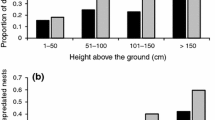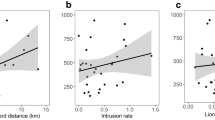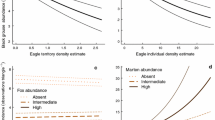Abstract
Intraguild (IG) predation and interspecific competition may affect the settlement and success of species in their habitats. Using data on forest-dwelling hawks from Finland, we addressed the impact of an IG predator, the northern goshawk Accipiter gentilis (goshawk), on the breeding of an IG prey, the common buzzard Buteo buteo. We hypothesized that the subordinate common buzzard avoids breeding in the proximity of goshawks and that interspecific competitors, mainly Strix owls, may also disturb common buzzards by competing for nests and food. Our results show that common buzzards more frequently occupied territories with a low IG predation threat and with no interspecific competitors. We also observed that common buzzards avoided territories with high levels of grouse, the main food of goshawks, possibly due to a risk of IG predation since abundant grouse can attract goshawks. High levels of small rodents attracted interspecific competitors to common buzzard territories and created a situation where there was not only an abundance of food but also an abundance of competitors for the food. These results suggest interplay between top–down and bottom–up processes which influence the interactions between avian predator species. We conclude that the common buzzard needs to balance the risks of IG predation and interference competition with the availability of its own resources. The presence of other predators associated with high food levels may impede a subordinate predator taking full advantage of the available food. Based on our results, it appears that interspecific interactions with dominant predators have the potential to influence the distribution pattern of subordinate predators.


Similar content being viewed by others
References
Aars J, Ims RA (2002) Intrinsic and climatic determinants of population demography: the winter dynamics of tundra voles. Ecology 83:3449–3456. doi:10.1890/0012-9658(2002)083[3449:IACDOP]2.0.CO;2
Arim M, Marquet PA (2004) Intraguild predation: a widespread interaction related to species biology. Ecol Lett 7:557–564. doi:10.1111/j.1461-0248.2004.00613.x
Bates D, Maechler M, Bolker B, Walker S (2014) Package ‘lme4’. Linear mixed-effects models using Eigen and S4, version 1.0-6. https://cran.r-project.org/web/packages/lme4/lme4.pdf
Baum JK, Worm B (2009) Cascading top-down effects of changing oceanic predator abundances. J Anim Ecol 78:699–714. doi:10.1111/j.1365-2656.2009.01531.x
Begon M, Townsend CR, Harper JL (2005) Ecology: from individuals to ecosystems, 4th edn. Blackwell, Malden
Bijlsma RG (2004) What is the predation risk for European honey buzzards Pernis apivorus in Dutch forests inhabited by food-stressed northern goshawks Accipiter gentilis? De Takkeling 12:185–197
Bivand R (2014) Package ‘spdep’. Spatial dependence: Weighting schemes, statistics and models, version 0.5-71
Buchanan JB, Gutiérrez RJ, Anthony RG, Cullinan T, Diller LV, Forsman ED, Franklin AB (2007) A synopsis of suggested approaches to address potential competitive interactions between barred owls (Strix varia) and spotted owls (S. occidentalis). Biol Invasions 9:679–691. doi:10.1007/s10530-006-9068-7
Burnham K, Anderson D (2002) Model selection and multimodel inference. A practical information-theoretic approach, 2nd edn. Springer SBM, New York
Byholm P, Saurola P, Lindén H, Wikman M (2003) Causes of dispersal in northern goshawks (Accipiter gentilis) in Finland. Auk 120:706–716. doi:10.2307/4090101
Chakarov N, Krüger O (2010) Mesopredator release by an emergent superpredator: a natural experiment of predation in a three level guild. PLOS ONE 5:e15229. doi:10.1371/journal.pone.0015229
Cramp S, Simmons KEL (1980) Handbook of the birds of Europe, the Middle East and North Africa: The birds of the Western Palearctic, hawks to bustards. Oxford University Press, Oxford
Cresswell W (2008) Non-lethal effects of predation in birds. Ibis 150:3–17. doi:10.1111/j.1474-919X.2007.00793.x
Crozier ML, Seamans ME, Gutiérrez RJ, Loschl PJ, Horn RB, Sovern SG, Forsman ED (2006) Does the presence of barred owls suppress the calling behavior of spotted owls? Condor 108:760–769
Daugherty MP, Harmon JP, Briggs CJ (2007) Trophic supplements to intraguild predation. Oikos 116:662–677. doi:10.1111/j.2007.0036-1299.15378.x
Dormann CF, Elith J, Bacher S, Buchmann C, Carl G, Carré G, Marquéz JRG, Gruber B, Lafourcade B, Leitão PJ, Münkemüller T, McClean C, Osborne PE, Reineking B, Schröder B, Skidmore AK, Zurell D, Lautenbach S (2013) Collinearity: a review of methods to deal with it and a simulation study evaluating their performance. Ecography 36:027–046. doi:10.1111/j.1600-0587.2012.07348.x
Fielding AH, Haworth PF, Morgan DH, Thompson DBA, Whitfield DP (2003) The impact of golden eagles (Aquila chrysaetos) on a diverse bird of prey assemblage. In: Thompson DBA, Redpath SM, Fielding AH, Marquiss M, Galbraith CA (eds) Birds of prey in a changing environment. The Stationary Office, Edinburgh, pp 221–243
Gelman A (2008) Scaling regression inputs by dividing by two standard deviations. Stat Med 27:2865–2873. doi:10.1002/sim.3107
Greenville AC, Wardle GM, Tamayo B, Dickman CR (2014) Bottom–up and top–down processes interact to modify intraguild interactions in resource-pulse environments. Oecologia 175:1349–1358. doi:10.1007/s00442-014-2977-8
Grueber CE, Nakagawa S, Laws RJ, Jamieson IG (2011) Multimodel inference in ecology and evolution: challenges and solutions. J Evol Biol 24:699–711. doi:10.1111/j.1420-9101.2010.02210.x
Gurevitch J, Morrison JA, Hedges LV (2000) The interaction between competition and predation: a meta-analysis of field experiments. Am Nat 155:435–453. doi:10.1086/303337
Hakkarainen H, Korpimäki E (1996) Competitive and predatory interactions among raptors: an observational and experimental study. Ecology 77:1134–1142. doi:10.2307/2265582
Hakkarainen H, Mykrä S, Kurki S, Tornberg R, Jungell S (2004) Competitive interactions among raptors in boreal forests. Oecologia 141:420–424. doi:10.1007/s00442-004-1656-6
Heithaus MR, Dill LM (2002) Food availability and tiger shark predation risk influence bottlenose dolphin habitat use. Ecology 83:480–491. doi:10.2307/2680029
Hurlbert SH (1984) Pseudoreplication and the design of ecological field experiments. Ecol Monogr 54:187–211. doi:10.2307/1942661
Jeppesen E, Jensen JP, Søndergaard M, Lauridsen T, Pedersen LJ, Jensen L (1997) Top-down control in freshwater lakes: the role of nutrient state, submerged macrophytes and water depth. Hydrobiologia 342–343:151–164. doi:10.1023/A:1017046130329
Jiménez-Franco MV, Martínez JE, Calvo JF (2014) Patterns of nest reuse in forest raptors and their effects on reproductive output. J Zool 292:64–70. doi:10.1111/jzo.12085
Jonker RM, Chakarov N, Krüger O (2014) Climate change and habitat heterogeneity drive a population increase in common buzzards Buteo buteo through effects on survival. Ibis 156:97–106. doi:10.1111/ibi.12124
Kontkanen H, Nevalainen T (eds) (2002) Birds of prey and forestry (in Finnish). Siipirikko 29:1–80. Available at: www.pklty.fi/eSR/SR-2002-2-PeMe.pdf
Korpela K, Delgado M, Henttonen H, Korpimäki E, Koskela E, Ovaskainen O, Pietiäinen H, Sundell J, Yoccoz NG, Huitu O (2013) Nonlinear effects of climate on boreal rodent dynamics: mild winters do not negate high-amplitude cycles. Glob Chang Biol 19:697–710. doi:10.1111/gcb.12099
Korpimäki E (1986) Niche relationships and life-history tactics of three sympatric Strix owl species in Finland. Ornis Scand 17:126–132. doi:10.2307/3676861
Kostrzewa A (1991) Interspecific interference competition in three European raptor species. Ethol Ecol Evol 3:127–143. doi:10.1080/08927014.1991.9525379
Krüger O (2002a) Interactions between common buzzard Buteo buteo and goshawk Accipiter gentilis: trade-offs revealed by a field experiment. Oikos 96:441–452. doi:10.1034/j.1600-0706.2002.960306.x
Krüger O (2002b) Analysis of nest occupancy and nest reproduction in two sympatric raptors: common buzzard Buteo buteo and goshawk Accipiter gentilis. Ecography 25:523–532. doi:10.1034/j.1600-0587.2002.250502.x
Krüger O (2004) The importance of competition, food, habitat, weather and phenotype for the reproduction of buzzard Buteo buteo. Bird Study 51:125–132. doi:10.1080/00063650409461344
Krüger O, Lindström J, Amos W (2001) Maladaptive mate choice maintained by heterozygote advantage. Evolution 55:1207–1214. doi: 10.1111/j.0014-3820.2001.tb00640.x
Laundré JW, Hernández L, López Medina P, Campanella A, López-Portillo J, González-Romero A, Grajales-Tam KM, Burke AM, Gronemeyer P, Browning DM (2014) The landscape of fear: the missing link to understand top-down and bottom-up controls of prey abundance? Ecology 95:1141–1152. doi:10.1890/13-1083.1
Lehikoinen A, Byholm P, Ranta E, Saurola P, Valkama J, Korpimäki E, Pietiäinen H, Henttonen H (2009) Reproduction of the common buzzard at its northern range margin under climatic change. Oikos 118:829–836. doi:10.1111/j.1600-0706.2008.17440.x
Lindén H, Wikman M (1983) Goshawk predation on tetraonids: availability of prey and diet of the predator in the breeding season. J Anim Ecol 52:953–968. doi:10.2307/4466
Lindén H, Helle E, Helle P, Wikman M (1996) Wildlife triangle scheme in Finland: methods and aims for monitoring wildlife populations. Finnish Game Res 49:4–11
Lõhmus A (2006) Nest-tree and nest-stand characteristics of forest-dwelling raptors in east-central Estonia: implications for forest management and conservation. Proc Estonian Acad Sci Biol Ecol 55:31–50
Martínez JE, Martínez JA, Zuberogoitia I, Zabala J, Redpath SM, Calvo JF (2008) The effect of intra- and interspecific interactions on the large-scale distribution of cliff-nesting raptors. Ornis Fenn 85:13–21
Mikkola H (1976) Owls killing and killed by other owls and raptors in Europe. Br Birds 69:144–154
Mikkola-Roos M, Tiainen J, Below A, Hario M, Lehikoinen A, Lehikoinen E, Lehtiniemi T, Rajasärkkä A, Valkama J, Väisänen R (2010) Birds. In: Rassi P, Hyvärinen E, Juslén A, Mannerkoski I (eds) The 2010 Red List of Finnish species. Ympäristöministeriö & Suomen ympäristökeskus, Helsinki, pp 320–331
Møller AP, Solonen T, Byholm P, Huhta E, Nielsen JT, Tornberg R (2012) Spatial consistency in susceptibility of prey species to predation by two Accipiter hawks. J Avian Biol 43:390–396. doi:10.1111/j.1600-048X.2012.05723.x
Morosinotto C, Thomson RL, Korpimäki E (2010) Habitat selection as an antipredator behaviour in a multi-predator landscape: all enemies are not equal. J Anim Ecol 79:327–333. doi:10.1111/j.1365-2656.2009.01638.x
Pace ML, Cole JJ, Carpenter SR, Kitchell JF (1999) Trophic cascades revealed in diverse ecosystems. TREE 14:483–488. doi:10.1016/S0169-5347(99)01723-1
Pakkala T, Kouki J, Tiainen J (2006) Top predator and interference competition modify the occurrence and breeding success of a specialist species in a structurally complex forest environment. Ann Zool Fenn 43:137–164. www.sekj.org/PDF/anzf43/anzf43-137.pdf
Palomares F, Caro TM (1999) Interspecific killing among mammalian carnivores. Am Nat 153:492–508. doi:10.1086/303189
Pearson RR, Livezey KB (2003) Distribution, numbers and site characteristics of spotted owls and barred owls in the Cascade Mountains of Washington. J Raptor Res 37:265–276
Penteriani V (2002) Goshawk nesting habitat in Europe and North America: a review. Ornis Fenn 79:149–163. Available at: www.ornisfennica.org/search.htm
Penteriani V, Rutz C, Kenward R (2013) Hunting behaviour and breeding performance of northern goshawks Accipiter gentilis, in relation to resource availability, sex, age and morphology. Naturwissenschaften 100:935–942. doi:10.1007/s00114-013-1093-7
Petty SJ, Anderson DIK, Davison M, Little B, Sherratt TN, Thomas CJ, Lambin X (2003) The decline of common kestrels Falco tinnunculus in a forested area of northern England: the role of predation by northern goshawks Accipiter gentilis. Ibis 145:472–483. doi:10.1046/j.1474-919X.2003.00191.x
Pokrovsky I, Lecomte N (2010) Peregrine falcons kill a gyrfalcon feeding on their nestling. J Raptor Res 44:66–69
Polis GA, Holt RD (1992) Intraguild predation: the dynamics of complex trophic interactions. Trends Ecol Evol 7:151–154. doi:10.1016/0169-5347(92)90208-S
Polis GA, Myers CA, Holt RD (1989) The ecology and evolution of intraguild predation: potential competitors that eat each other. Annu Rev Ecol Syst 20:297–330. doi:10.1146/annurev.es.20.110189.001501
Poole KG, Bromley RG (1988) Interrelationships within a raptor guild in the central Canadian Arctic. Can J Zool 66:2275–2287. doi:10.1139/z88-338
Potapov E (1997) What determines the population density and reproductive success of rough-legged buzzards, Buteo lagopus, in the Siberian tundra? Oikos 78:362–376. doi:10.2307/3546304
Preisser EL, Bolnick DI, Benard MF (2005) Scared to death? The effects of intimidation and consumption in predator-prey interactions. Ecology 86:501–509. doi:10.1890/04-0719
R Core Team (2013) R: A language and environment for statistical computing, version 3.0.2. R Foundation for Statistical Computing, Vienna
Rebollo S, Pérez-Camacho L, García-Salgado G, Martínez-Hesterkamp S, Fernández-Pereira JM, Rebollo M, Rebollo P, de la Montaña E (2011) Spatial relationship among northern goshawk, Eurasian sparrowhawk and common buzzard: Rivals or partners? In: Zuberogoitia I, Martínez JE (eds) Ecology and conservation of European forest-dwelling raptors. Departamento de Agricultura de la Diputación Foral de Bizkaia, Bizkaia, pp 159–167
Reif V, Tornberg R, Jungell S, Korpimäki E (2001) Diet variation of common buzzards in Finland supports the alternative prey hypothesis. Ecography 24:267–274. doi: 10.1034/j.1600-0587.2001.240304.x
Ritchie EG, Johnson CN (2009) Predator interactions, mesopredator release and biodiversity conservation. Ecol Lett 12:982–998. doi:10.1111/j.1461-0248.2009.01347.x
Rutz C, Bijlsma RG (2006) Food-limitation in a generalist predator. Proc R Soc B Biol Sci 273:2069–2076. doi:10.1098/rspb.2006.3507
Santangeli A, Lehtoranta H, Laaksonen T (2012) Successful voluntary conservation of raptor nests under intensive forestry pressure in a boreal landscape. Anim Conserv 15:571–578. doi:10.1111/j.1469-1795.2012.00551.x
Saurola P, Valkama J, Velmala W (2013) The Finnish bird ringing atlas, vol I. Finnish Museum of Natural History Luomus and Ministry of Environment, Helsinki
Schoener TW (1983) Field experiments on interspecific competition. Am Nat 122:240–285. Available at: www.jstor.org/stable/2461233
Selås V, Steen OF, Johnsen JT (2008) Goshawk breeding densities in relation to mature forest in southeastern Norway. For Ecol Manag 256:446–451. doi:10.1016/j.foreco.2008.04.047
Sergio F, Hiraldo F (2008) Intraguild predation in raptor assemblages: a review. Ibis 150:132–145. doi:10.1111/j.1474-919X.2008.00786.x
Sergio F, Marchesi L, Pedrini P (2003) Spatial refugia and the coexistence of a diurnal raptor with its intraguild owl predator. J Anim Ecol 72: 232–245. doi: 10.1046/j.1365-2656.2003.00693.x
Sergio F, Marchesi L, Pedrini P, Penteriani V (2007) Coexistence of a generalist owl with its intraguild predator: distance-sensitive or habitat-mediated avoidance? Anim Behav 74:1607–1616. doi:10.1016/j.anbehav.2006.10.022
Sidorovich VE, Solovej IA, Sidorovich AA, Rotenko II (2008) Effect of felling on the distribution of rodents and their predators in a transitional mixed forest. Pol J Ecol 56:309–321. Available at: www.pje.miiz.waw.pl
Sih A, Crowley P, McPeek M, Petranka J, Strohmeier K (1985) Predation, competition, and prey communities: a review of field experiments. Ann Rev Ecol Syst 16:269–311. doi:10.1146/annurev.es.16.110185.001413
Sulkava S, Linkola P, Lokki H (2006) The diet of the goshawk Accipiter gentilis during the nesting season in Häme (Southern Finland). Suomen Riista 52:85–96
Thompson CM, Gese EM (2007) Food webs and intraguild predation: community interactions of a native mesocarnivore. Ecology 88:334–346. doi:10.1890/0012-9658(2007)88[334:FWAIPC]2.0.CO;2
Tike, Information Centre of the Ministry of Agriculture and Forestry (2014) Utilised agricultural area (e-publication). Available at: www.stat.fi/til/kaoma/index_en.html
Tornberg R (2001) Pattern of goshawk Accipiter gentilis predation on four forest grouse species in northern Finland. Wildl Biol 7:245–256. Available at:www.wildlifebiology.com/Downloads/Article/342/En/7_4_tornberg.pdf
Tornberg R, Korpimäki E, Byholm P (2006) Ecology of the northern goshawk in Fennoscandia. Stud Avian Biol 31:141–157. Available at: www.planetofbirds.com/northern-goshawk-article-2
Valkama J, Vepsäläinen V, Lehikoinen A (2011) The third Finnish Breeding bird atlas. Finnish Museum of Natural History and Ministry of Environment. Available at: http://atlas3.lintuatlas.fi/english. Accessed: 12 Dec 2014
van Lanen NJ, Franklin AB, Huyvaert KP, Reiser RF II, Carlson PC (2011) Who hits and hoots at whom? Potential for interference competition between barred and northern spotted owls. Biol Conserv 144:2194–2201. doi:10.1016/j.biocon.2011.05.011
Venäläinen A, Tuomenvirta H, Pirinen P, Drebs A (2005) A basic Finnish climate data set 1961–2000—description and illustrations. Rep Finn Meteorol Inst 5:1–27
Voous KH (1988) Owls of the Northern hemisphere. William Collins Sons & Co., London
Widén P (1997) How, and why, is the goshawk (Accipiter gentilis) affected by modern forest management in Fennoscandia. J Raptor Res 31:107–113
Ylitalo E (2013) Finnish statistical yearbook of forestry 2013. Finnish Forest Research Institute, Vantaa
Zuberogoitia I, Martínez JA, Zabala J, Martínez JE (2005) Interspecific aggression and nest-site competition in a european owl community. J Raptor Res 39:156–159
Zuberogoitia I, Martínez JE, Zabala J, Martínez JA, Azkona A, Castillo I, Hidalgo S (2008) Social interactions between two owl species sometimes associated with intraguild predation. Ardea 96:109–113. doi:10.5253/078.096.0112
Zuur AF, Ieno EN, Walker NJ, Saveliev AA, Smith GM (2009) Mixed effects models and extensions in ecology with R. Springer SBM, New York
Acknowledgments
We are grateful to the many volunteer bird-of-prey ringers for their long-term fieldwork. We thank Jukka Rintala for retrieving the grouse data, Henriikka Simola and Kaisa Välimäki for providing the weather data and Sanna Mäkeläinen for geoprocessing advice. We also want to acknowledge Sara Fraixedas and two anonymous reviewers for their comments that improved the manuscript. This study was supported by the Finnish Museum of Natural History Luomus. H.B. received funding from the Kone Foundation, the University of Helsinki, the Doctoral Programme in Wildlife Biology Research Luova of the University of Helsinki, and the Finnish Museum of Natural History Luomus. T.L. received funding from the Academy of Finland.
Author contribution statement
H.B. originally formulated the idea, H.B., A.S., J.V., T.L. designed the study, O.H., H.Le, H.Li. provided the data, H.B., A.S., F.G.B., J.V., T.L. contributed to methodology and analyses, H.B. performed statistical analyses and wrote the manuscript; all authors provided editorial advice.
Author information
Authors and Affiliations
Corresponding author
Ethics declarations
Conflict of interest
The authors declare that they have no conflict of interest.
Ethical approval
All applicable institutional and/or national guidelines for the care and use of animals were followed.
Additional information
Communicated by Hannu J. Ylonen.
Electronic supplementary material
Below is the link to the electronic supplementary material.
Online Resource 1
Hawk territory dynamics (PDF 94 kb)
Online Resource 2
Additional information on materials and methods (PDF 415 kb)
Online Resource 3
Figures 1–5: Figures on the data (PDF 472 kb)
Online Resource 4
The AICs of the occupancy and breeding success GLMMs with different goshawk threats (PDF 157 kb)
Rights and permissions
About this article
Cite this article
Björklund, H., Santangeli, A., Blanchet, F.G. et al. Intraguild predation and competition impacts on a subordinate predator. Oecologia 181, 257–269 (2016). https://doi.org/10.1007/s00442-015-3523-z
Received:
Accepted:
Published:
Issue Date:
DOI: https://doi.org/10.1007/s00442-015-3523-z




